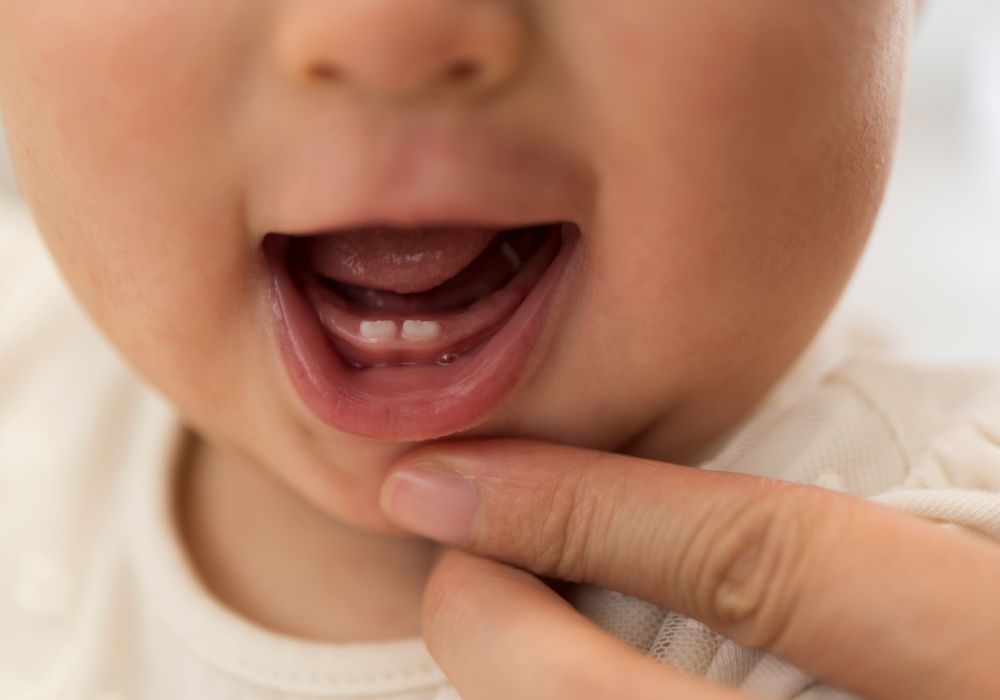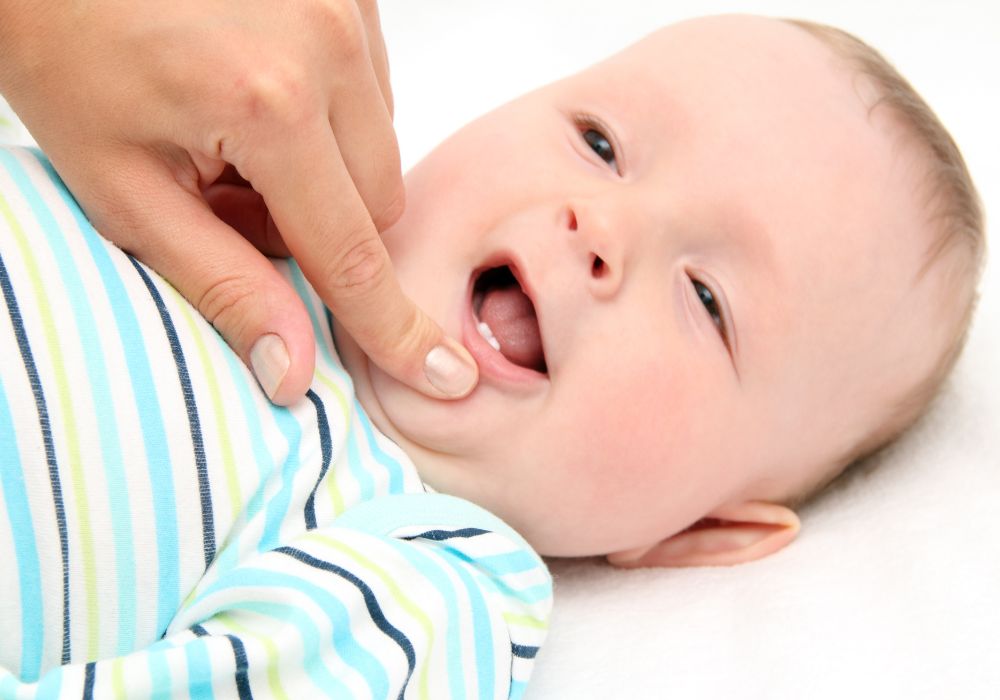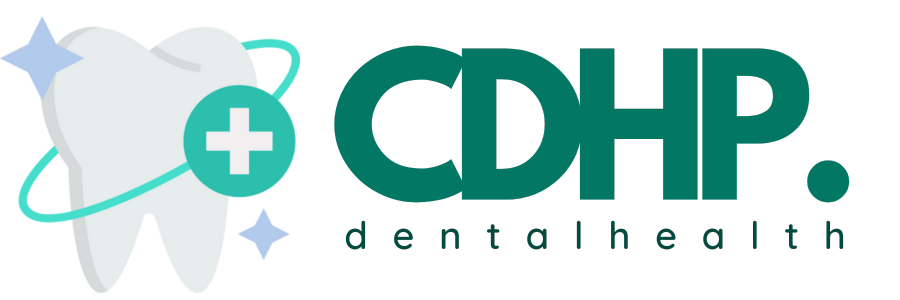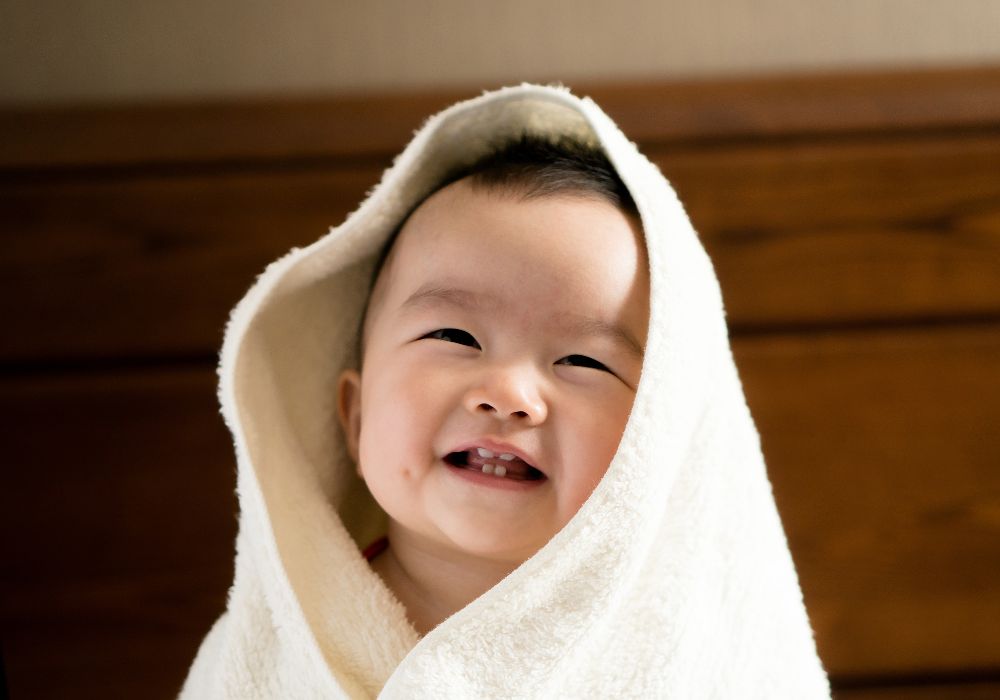The eruption of the first baby tooth is a joy for all parents, but it can be an unpleasant experience for babies because, during this period, the baby’s gums become swollen and inflamed, which is characterized by an increase in the baby’s irritability, crying, and drooling.
A lot of parents naturally want to help their children in these times, but they don’t know how to behave or even what to expect in this big developmental process.
Because of this, questions like “How many teeth should a 1-year-old have?” or “In what order do teeth erupt during the first year?” are more than common.
In this article, we will answer not only them but many other questions to help you prepare for the big first year!
Can a Baby Be Born with Teeth?

Before dealing with the questions mentioned in the intro, we need to discuss a subject that not many people know about – natal teeth. Natal teeth are the teeth with which a baby is born.
A lot of folks are not knowledgeable regarding this topic because natal teeth aren’t a common occurrence – only 1 out of every 2,5 babies comes into this world ready to bite.
This possibility shouldn’t come as a huge surprise because baby teeth actually start developing while it’s in the mother’s womb. Also, don’t panic if your baby happens to be born with some teeth – it’s just a rare thing and, in a vast majority of cases, not a sign that your baby has some kind of a health condition.
Still, because this is not something we (and doctors, for that matter) witness every day, the parents should consult a dentist.
What is Neonatal Teeth?
Now that we’re done with natal teeth, it’s time to talk about something that’s even rarer – neonatal teeth.
Neonatal teeth are baby teeth that appear in the first month of a baby’s life, and as we said, they’re even less common than the natal teeth – for every three persons that get born with teeth, there’s a person who develops teeth in the first month of their existence.
Similarly to natal teeth, in most instances, they are not symptoms of any particular health problem, but because they can be sharp, neonatal teeth sometimes cause problems with breathing or breastfeeding, which is why doing a dental checkup is a must.
When do Primary Teeth Erupt?
OK, now to the “normal” teeth. First or primary baby teeth are known to erupt during a somewhat large time frame since there are no two identical babies. Even with identical twins, there is no guarantee that their teeth will develop at the same rate.
Somewhere around the third month, the baby will start to explore the world with its mouth and try to stuff everything and anything in it, which is one of the signs that the teeth will erupt from the gums and delight the parents with their whiteness.
Your baby suddenly becoming a gourmet should also serve as a sign to keep the baby’s environment free of objects that can be swallowed.
Sometimes after this period, usually 6 months into the first year, you can expect the primary teeth, which are also called deciduous, milk, or baby teeth, to appear.
However, don’t be surprised if this takes place as early as three months or as late as 12 months into the baby’s life. In case nothing happens even after 12 months, then it is time to visit the dentist.
How Many Teeth Should a 1-Year-Old Have?
In order for us to learn how many teeth a 1-year-old should have, we need to take a look at the order of teeth eruption in babies.
The first to appear is a pair of lower central incisors, i.e., the very front two teeth located on the lower jaw. They erupt some 6-10 months into the first year. Not long after them, usually after 8-12 months, the upper central incisors pop up.
Although this is a rare thing, in some babies, the down central incisors appear after the top ones have emerged on the scene.
In the next stage of teeth eruption (9-13 months in), the baby gets the upper lateral incisors. Upper or top lateral incisors, as they are also called, are the two teeth that are located to the right and left of the sides of the top central incisors. The lower lateral incisors appear when the baby is 10-16 months of age.
Besides incisors, there are different types of teeth, such as first molars, second molars, third molars (aka wisdom teeth), upper canines, and lower canines.
However, they erupt in the second and third year, which, combined with the previously described process of incisors teeth eruption, means that a one-year-old baby should have between 4 and 8 teeth.
For any concerned parent whose kid might not have this many teeth even though they turned one year of age, we would like to remind them once again that it isn’t something that should make them super anxious.
What Purpose Do Baby Teeth Serve?
Whether it’s incisors, canines, or molars, you probably remember a lot of your baby teeth falling out, which is why it’s perfectly normal to ask what purpose they serve if they’re eventually going to be replaced.
Baby teeth are whiter and smaller than permanent or adult teeth. Although they are in the oral cavity temporarily and precede the growth of permanent teeth, baby teeth save space for permanent teeth and encourage normal growth and development of the jaws.
They enable chewing, which is a prerequisite for good digestion, and are used in creating voices and developing clear and understandable speech. They also significantly affect the aesthetic appearance of the face, which contributes to the proper psychological development of the child.
Baby Teeth and Hygiene
A big question every new parent faces is when to start with oral hygiene.
It is best to start before the milk teeth emerge by rinsing the mouth with water and wiping the oral cavity with a clean washcloth.
When baby teeth erupt, you should start brushing them gently with a soft toothbrush whose size is appropriate for the child’s age and water without using fluoride toothpaste.
Besides regular tooth brushing, it is important to reduce the intake of certain foods such as chocolates, candies, crackers, smokes, and the like. Avoiding sweet drinks and sweetened foods in the evening and at night is especially important.
The reason for this is that during sleep, much less saliva, which protects the teeth from bad bacteria, is secreted, so the sugars remain on the surface, and the bacteria reproduce much more easily and cause tooth decay.
What are the Most Common Symptoms of Teeth Eruption?

Symptoms characteristic of the eruption of the first teeth are as follows:
1. Drooling
Your baby drooling in the first three months is most often due to the opening of its salivary gland. Drooling after the first trimester, though, is a sign that the baby’s first teeth will appear soon. The reason why baby drool is that saliva is a natural way of relieving pain and helping inflamed gums.
2. Rashes
Increased drooling and rashes go hand in hand. Some babies drool so much that the rash spreads to their necks. The baby’s skin should be patted more often with a clean cloth (do not wipe, as this only makes the condition worse), while a fatty cream should be applied to the irritated area in order to create a protective layer.
3. Crying
Babies aren’t elaborate public speakers, which is why they communicate by crying and smiling. A lot of crying in the second trimester means your baby’s trying to tell you that the first tooth is on its way.
4. Decreased appetite
When the first teeth start appearing, the baby’s gums get inflamed and swollen, making the baby feel a not-so-comfortable sensation in the mouth. During this period, food or a spoon touching the gum can be painful, which is why the baby might not want to eat a lot until the tooth fully erupts.
5. Gums itching
Teeth eruption can also lead to some gum itching. When this happens, the baby will start to put the fingers and every other object around itself in the mouth, hoping to reduce the itching.
6. Slightly increased temperature
Parents are often inclined to attribute really high temperatures to teething. But that is a mistake since teething is often accompanied by a slightly increased body temperature.
Namely, the temperature that occurs due to teething is never higher than 100° F (38° C). Anything higher than that is a sign your baby should see a doctor.
Conclusion
In conclusion, a 1-year-old baby should have between 4 and 8 teeth. Remember, though, that we’re all different, and this isn’t something set in stone.
If, however, your baby doesn’t have any teeth by the end of the first year, you should make an appointment with the dentist.
Please let us know in the comments how did the adventure with your baby’s first teeth go! Also, don’t forget to use the comment section for any questions regarding the topic.

